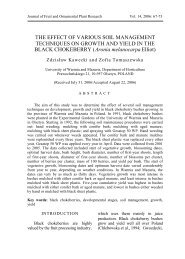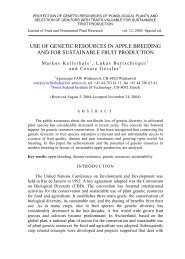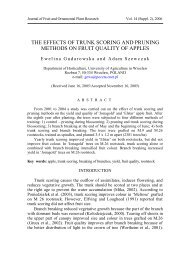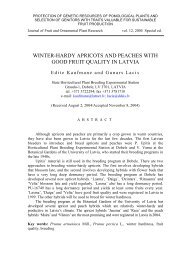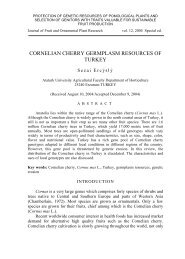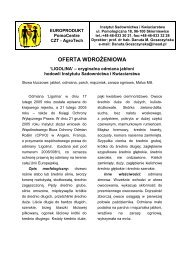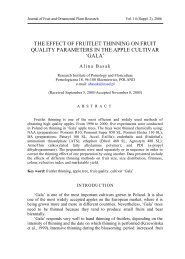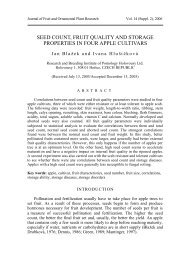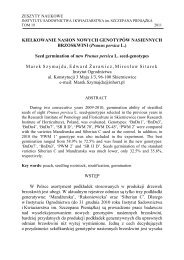MICROCLONAL PROPAGATION OF Vaccinium SP. AND Rubus SP ...
MICROCLONAL PROPAGATION OF Vaccinium SP. AND Rubus SP ...
MICROCLONAL PROPAGATION OF Vaccinium SP. AND Rubus SP ...
Create successful ePaper yourself
Turn your PDF publications into a flip-book with our unique Google optimized e-Paper software.
A. Gajdošová et al.characteristic polymorphic banding patterns. However, there were no differences inthe DNA profiles of the mother cultivars and any of the clones derived from them.Therefore, either no somaclonal variation occurred during the micropropagationprocess, or more sensitive techniques are needed to detect it. Flow-cytometry did notdetect any changes in ploidy level, which confirms that no relative changes in DNAcontent took place during the micro-propagation process.Key words: <strong>Vaccinium</strong> sp., <strong>Rubus</strong> sp., in vitro regeneration, RAPD, flow-cytometryAbbreviations: AN – Anderson rhododendron medium; TDZ – thidiazuron; BAP –6-benzylaminopurine; 2-iP – dimethylallylaminopurine; IBA – indole-3-butyric acid;2,4-D – 2,4-dichlorophenoxyacetic acid; DNA – deoxinucleic acid; RAPD – Randomamplified polymorphic DNA analysis.INTRODUCTIONBerry fruits are an economically important crop in many countries.Interest in berry fruits has recently increased because they are excellentsources of health-promoting vitamins, anti-oxidants and other valuablenutrients (Song and Sing, 2004). In Slovakia, however, berry productionsharply decreased during the 1990s in spite of the fact that soil and climateconditions in Slovakia are excellent for the intensive cultivation of berryfruits. There are also many unique berry cultivars which lend themselves tointensive cultivation. Recently, interest in growing various berry fruits hadbeen increasing not only among home gardeners, but also among smallfarmers. Berry culture is increasing in sub-mountainous areas of the country,where soil and climate conditions are more favorable for intensive berryculture than in the lowland areas.Some berry cultivars recently introduced into Slovakia are potentiallyprofitable alternative and non-conventional fruit crops. Among them arecultivars of the high-bush blueberry (<strong>Vaccinium</strong> corymbosum L.), the lingonberry(<strong>Vaccinium</strong> vitis-idaea L.), and the raspberry (<strong>Rubus</strong> idaeus L.). InSlovakia, lingonberry production has predominantly relied on the collection ofthe berries from stands of native varieties growing wild in the mountains.Habitat destruction has lead to a reduction in the supply of nativelingonberries. Although these native wild varieties are not as suitable forintensive culture as are the new cultivars, they are still very valuable becauseof their high dietary value and breeding potential. They can be a versatile rawmaterial for the food processing and pharmaceutical industries.High-bush blueberry and lingonberry plantations have already beenestablished at the Research Station of the Grassland and MountainAgricultural Research Institute in Krivá na Orave in northern Slovakia.Various berry cultivars are propagated by cuttings at this station. The genus<strong>Rubus</strong> includes many valuable cultivated species and varieties. <strong>Rubus</strong>varieties are propagated vegetatively. However, traditional techniques are not104J. Fruit Ornam. Plant Res. vol. 14 (Suppl. 1), 2006: 103-119




